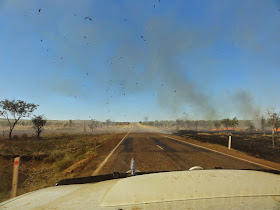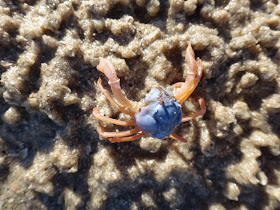The Gibb River Road is an unsealed former cattle route that stretches almost 660 kilometres from Derby to Wyndham through the heart of the Kimberley. The road leads through very large cattle stations and is fairly uninteresting in itself, the many side trips, however, are the highlights.
Kirsten soaking in Bell Creek.
Tunnel Creek flows through a 750 m natural cave through the Oscar Range and one can wade through it in the dry season. Note the "rope" hanging down: It's the root of a rock fig growing on top of the range and penetrating into the limestone to reach water.
Dimond Gorge is within the Mornington Wildlife Sanctuary, which is run by AWC (Australian Wildlife Conservancy). They have 23 sanctuaries all over Australia covering over 3 million hectares and protecting hundreds of fauna species and their habitat, including 346 threatened species. Truly staggering! I've been supporting them for over a decade so it was really nice to visit Mornington for a few days.
Below Sir John Gorge, also in Mornington.
Kirsten getting a head massage under a waterfall in Manning Gorge.
Geikie Gorge can only be accessed by boat, so we joined a tour. Note the high water mark during the wet season!
Grevillea Gorge on Charnley River Station has some amazing aboriginal rock art. We had to climb over rocks, through pandanus thickets and down two waterfalls to find it.
Scrambling around to look for aboriginal rock art under overhangs is heaps of fun!
The figures are mostly of Wandjina, the creator beings of the Dreaming for the Worrorra, Wunambal, and Ngarinyin people of the north-western and central Kimberley.
...river crossings, ....
...dust, ....
...huge trucks! We had to get off the road to avoid this one!
... the Kimberley Rose (Brachychiton viscidulus).
Some of the boabs are huge! They are deciduous and shed their leaves during the dry winter period.
Below a sundew (Drosera sp.), a carnivorous plant in the process of digesting a dragon fly.
Most creeks in the Kimberley have freshwater crocodiles (Crocodylus johnstoni), which are harmless to humans unless provoked.
I think this goanna mis-identified itself!
A water monitor (Varanus mertensi) below....
... and a gecko (Gehyra dubia).
Having a shower on a campground in the Kimberley usually means having a shower with frogs! The common Green Tree Frog (Litoria caerulea) below, ...
... a Northern Giant Frog (Cyclorana australis), ...
... and a Northern Laughing Tree Frog (Litoria (Pengilleyia) rothii).
Below, a Banded Tree Snake (Boiga irregularis) hiding in a rock crevice in Galvans Gorge.
Reptile identification by Alex Dudley - thanks Alex!
A constant companion in northern Australia is the Whistling Kite (Haliastur sphenurus). I love to hear their call every morning! Check it out on:
https://soundcloud.com/nature-sounds/whistling-kite-haliastur-sphenurus-1
Other common birds include Little Corella (Cacatua sanguinea).....
... Double‐barred Finch (Taeniopygia bichenovii).



























































































